
July 1, 2020
How will the global pandemic that has rocked the entertainment sector forever change our industry as we begin to reopen the economy?
Let’s first look to the past to understand how the world survived the deadliest modern pandemic.
The 1918 “Spanish Flu” infected nearly 1/3 of the world population in three separate waves between 1918-1919 with an estimated fatality rate of 2%. The first reported case was at Camp Funston in Fort Riley, Kansas in March 1918. The H1N1 was considered “novel” meaning it was so new at the time there was no immunity built up in the human race. The lack of antibiotics, poor hygiene, crowded living conditions and the fact that we were in the tail end of World War I all helped spread the virus globally. In an effort to curb the spread, tactics like isolation, quarantine, disinfectants, limiting public gathers and wearing masks were all implemented – sound familiar? It was coined “crowding control” back then. During the 1918 pandemic masks were suggested to be worn for up to 2 years. It also affected everyone but strangely killed the healthiest people. Also, viruses weren’t discovered until the 1930’s so the term virus was none existent. The pandemic ended in the summer of 1919 with those infected either dying or having developed an immunity. With the end of the Great War and the global pandemic came the roaring 20’s and people need to socialize! The economy grew 42% during this time.
Fast forward a 100 years.
Before our current pandemic, the US economy was at an all-time high and unemployment was low. As the outbreak was increasing in other countries of the world technology allowed us to see its impacts unfold (whether accurate or not). Technology might have been able to be used to help us not repeat the past. Several factors may have helped – truthful accurate reporting, listening to scientists and medical professionals, and defining the priority. Social distancing is better defined as physical distancing because we are still connected even during lockdown. Staying in touch feeds the human connection that we all need. What is missing is the emotional connection that comes from being in the physical presence of a group.
How will we react after our current outbreak? Will we have another cultural renaissance or will consumers be leery to get out and spend? The shelter in place restriction was long enough to force new habits. But if history tells us anything about humanity, once we navigate through a pandemic, people tend to run from isolation to some form of mega-socialization.
So how do we prepare for what is hopefully another explosion of spending? What are some key factors that consumers will require in order to jump-start your business? A few suggestions that can lead to a positive comeback.

1. BRAND LOVE
- Brand love is more important than ever in our current times. We are creatures of habit and tend to be drawn to things we know. Steve Bryant of Article Group quoted “People care about what they already care about.”
- Cultivating passionate fans takes positive emotional connection and self-brand integration.
- To create superfans you must master the power of your story – shape the narrative.
- Respect your customer
2. BUILD TRUST
- You must consider the four dimensions of trust
-
- Physical – do I feel safe? Use design to emphasize safety.
- Emotional – can I trust that you are being honest? Communication is paramount.
- Digital – can I believe that all my information is secure? Use technology to safeguard data.
- Financial – can I accept that my economic concerns are being served? Understand your customers are the most important commodity.
-
3. LEVERAGE TECHNOLOGY
- We are in an app world, use it to elevate your business.
- Technology can drive efficiencies and productivity.
- Use technology to elevate your customers experience.
4. SET TRENDS
- Identify and prioritize revenue opportunities.
- Purpose driven customer playbooks – understand your customer needs and build a scalable process.
- Reservation/concierge will be important – create new interaction points for customers.
- Openness is more important than ever – evaluate you current conditions and modify.
- Control your guest flow through imaginative design not barriers – build on the experience.
- Safety first.
5. OPERATIONAL EFFICIENCIES
- Design efficiently, apply your money to enhance the customer experience.
- Doing more with less.
- Identify profit centers – exploit these areas with signage, branding and design.
- Staffing efficiencies, utilize technology and purposeful design.
- Offer less choices but make sure you do it exceptionally.
The increase in economics after each recession period is great. Understand where the market opportunity is and size your opportunity correctly. For the entertainment sector everything will feel new again. You get to shape the story on how your business will succeed. Be prepared as a company for speed and agility – we must learn quickly, constantly be pivoting and adjusting. Hard times build character and difficult times will bring market openings to strong companies.
Albert Einstein said it best, “The same thinking that has led you to where you are is not going to lead you to where you want to go.”
Founded in 1981, TK Architects is a full-service architectural firm that offers all professional design services in-house to simplify and streamline coordination, including: Architecture, Interior Design, Graphic Design, Structural Engineering, Mechanical, Electrical, and Plumbing Engineering. The firm’s focus is entertainment architecture and engineering, including cinema, bowling, bars/lounges, food service, and entertainment centers worldwide. TK Architects provides the right services at the right time to meet client’s specific needs, including: New Buildings, Tenant Interiors, Renovations, Facility Upgrades, and Maintenance.
For more information about TK Architects please visit www.tkarch.com or contact Jack C. Muffoletto, at jcmuffoletto@tkarch.com




